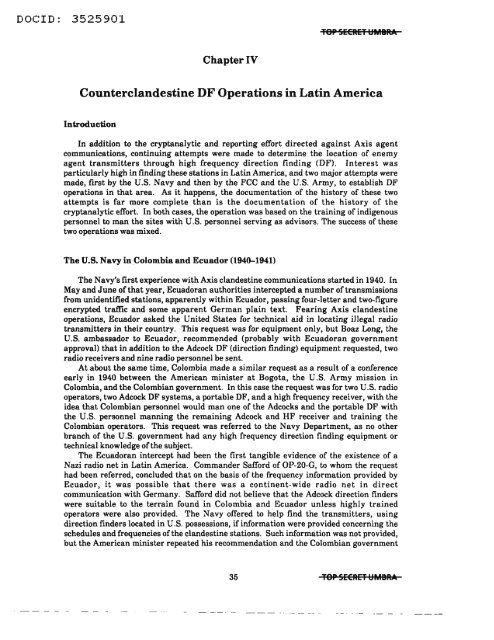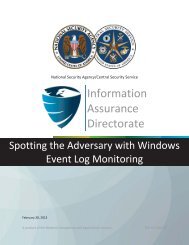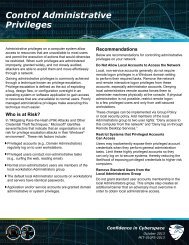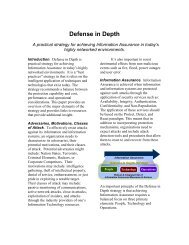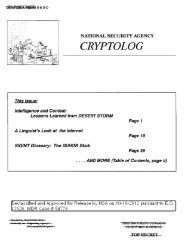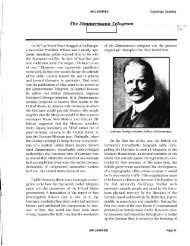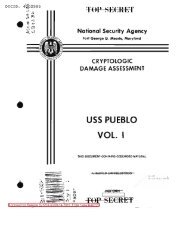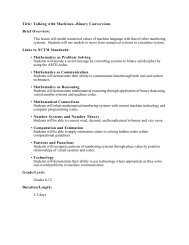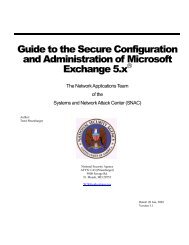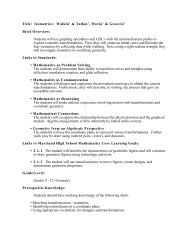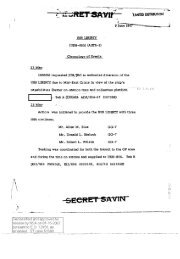German Clandestine Activities in South America in World War II
German Clandestine Activities in South America in World War II
German Clandestine Activities in South America in World War II
Create successful ePaper yourself
Turn your PDF publications into a flip-book with our unique Google optimized e-Paper software.
DOCID: 3525901<br />
Chapter IV<br />
Tap SECRET l:JMBRA<br />
Counterclandest<strong>in</strong>e DF Operations <strong>in</strong> Lat<strong>in</strong> <strong>America</strong><br />
Introduction<br />
In addition to the cryptanalytic and report<strong>in</strong>g effort directed aga<strong>in</strong>st Axis agent<br />
communications, cont<strong>in</strong>u<strong>in</strong>g attempts were made to determ<strong>in</strong>e the location of enemy<br />
agent transmitters through high frequency direction f<strong>in</strong>d<strong>in</strong>g (DF). Interest was<br />
particularly high <strong>in</strong> f<strong>in</strong>d<strong>in</strong>g these stations <strong>in</strong> Lat<strong>in</strong> <strong>America</strong>, and two major attempts were<br />
made, first by the U.S. Navy and then by the FCC and the U.S. Army, to establish DF<br />
operations <strong>in</strong> that area. As it happens, the documentation of the history of these two<br />
attempts is far more complete than is the documentation of the history of the<br />
cryptanalytic effort. In both cases, the operation was based on the tra<strong>in</strong><strong>in</strong>g of <strong>in</strong>digenous<br />
personnel to man the sites with U.S. personnel serv<strong>in</strong>g as advisors. The success of these<br />
two operations was mixed.<br />
The U.S. Navy <strong>in</strong>Colombia and Ecuador (1940-1941)<br />
The Navy's first experience with Axis clandest<strong>in</strong>e communications started <strong>in</strong> 1940. In<br />
May and June ofthat year, Ecuadoran authorities <strong>in</strong>tercepted a number oftransmissions<br />
from unidentified stations, apparently with<strong>in</strong> Ecuador, pass<strong>in</strong>g four-letter and two-figure<br />
encrypted traffic and some apparent <strong>German</strong> pla<strong>in</strong> text. Fear<strong>in</strong>g Axis clandest<strong>in</strong>e<br />
operations, Ecuador asked the United States for technical aid <strong>in</strong> locat<strong>in</strong>g illegal radio<br />
transmitters <strong>in</strong> their country. This request was for equipment only, but Boaz Long, the<br />
U.S. ambassador to Ecuador, recommended (probably with Ecuadoran government<br />
approval) that <strong>in</strong> addition to the Adcock DF (direction f<strong>in</strong>d<strong>in</strong>g) equipment requested, two<br />
radio receivers and n<strong>in</strong>e radio personnel be sent.<br />
At about the same time, Colombia made a similar request as a result of a conference<br />
early <strong>in</strong> 1940 between the <strong>America</strong>n m<strong>in</strong>ister at Bogota, the U.S. Army mission <strong>in</strong><br />
Colombia, and the Colombian government. In this case the request was for two U.S. radio<br />
operators, two Adcock DF systems, a portable DF, and a high frequency receiver, with the<br />
idea that Colombian personnel would man one of the Adcocks and the portable DF with<br />
the U.S. personnel mann<strong>in</strong>g the rema<strong>in</strong><strong>in</strong>g Adcock and HF receiver and tra<strong>in</strong><strong>in</strong>g the<br />
Colombian operators. This request was referred to the Navy Department, as no other<br />
branch of the U.S. government had any high frequency direction f<strong>in</strong>d<strong>in</strong>g equipment or<br />
technical knowledge ofthe subject.<br />
The Ecuadoran <strong>in</strong>tercept had been the first tangible evidence of the existence of a<br />
Nazi radio net <strong>in</strong> Lat<strong>in</strong> <strong>America</strong>. Commander Safford of OP-20-G, to whom the request<br />
had been referred, concluded that on the basis of the frequency <strong>in</strong>formation provided by<br />
Ecuador, it was possible that there was a cont<strong>in</strong>ent-wide radio net <strong>in</strong> direct<br />
communication with <strong>German</strong>y. Safford did not believe that the Adcock direction f<strong>in</strong>ders<br />
were suitable to the terra<strong>in</strong> found <strong>in</strong> Colombia and Ecuador unless highly tra<strong>in</strong>ed<br />
operators were also provided. The Navy offered to help f<strong>in</strong>d the transmitters, us<strong>in</strong>g<br />
direction f<strong>in</strong>ders located <strong>in</strong> U.S. possessions, if<strong>in</strong>formation were provided concern<strong>in</strong>g the<br />
schedules and frequencies ofthe clandest<strong>in</strong>e stations. Such <strong>in</strong>formation was not provided,<br />
but the <strong>America</strong>n m<strong>in</strong>ister repeated his recommendation and the Colombian government<br />
35 Tap SECRET l:JMBRA


